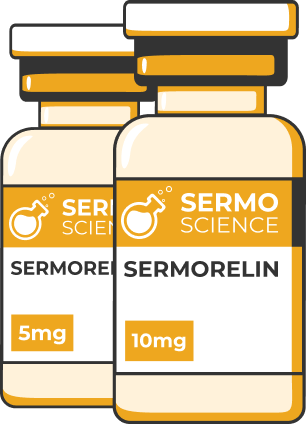Sermorelin Reconstitution Calculator and Dosage Chart
Understanding the correct dosage and reconstitution process is crucial for achieving the desired therapeutic outcomes. Whether you're a healthcare professional looking to refine your knowledge or a patient seeking to understand your treatment, our comprehensive guide on Sermorelin reconstitution and dosage is here to help you with this entire process. In this blog post, we'll provide an easy-to-use Sermorelin reconstitution calculator and dosage chart, designed to simplify your calculations, and ensure accurate dosing.

Sermorelin, functioning as an analog of Growth Hormone-Releasing Hormone (GHRH), is instrumental in regulating and stimulating the natural production of growth hormone within the body. The precision of dosing not only optimizes therapeutic outcomes but also safeguards against potential side effects.
Firstly, it's important to know the initial volume of Semaglutide in powder form and the desired concentration once it's mixed. The basic principle here is to add a specific volume of diluent (usually sterile or bacteriostatic water) to the powdered medication to achieve the correct concentration for injection.
Why Accuracy Matters
This medication aims to mimic your body&aos;s natural rhythms and processes as closely as possible. An accurate dose ensures your body receives the right signals, promoting optimal health and well-being without overburdening your system.
Taking Too Much
Going overboard with Sermorelin can lead to a lot of unwanted side effects. From swelling and discomfort at the injection site to more severe concerns like headaches, dizziness, and even symptoms resembling hyperactivity in the body's hormone levels. Your body likes harmony, and too much of a good thing can disrupt this delicate balance.
The Risks of Falling Short
On the other hand, an insufficient dose might leave you wondering if Sermorelin is doing anything at all. Underdosing can result in sluggish progress, delayed results, or the feeling that your therapy is a wasted effort.
Striking the Perfect Balance
Achieving the perfect Sermorelin dosage is an art backed by science. It involves understanding your unique physiological needs, adjusting for factors such as age, weight, and treatment goals, and possibly changes based on your response to therapy. This is where professionalism meets personalization, ensuring your body gets what it needs to thrive.
Reconstituting Sermorelin is a critical step in its administration, requiring precision and care to ensure the medication's efficacy and safety. The process involves dissolving the lyophilized (freeze-dried) powder into a solvent and preparing it for injection.
1. Preparation
Gather Supplies: Ensure you have the Sermorelin vial, bacteriostatic water, alcohol swabs, and sterile syringes.
Sanitize: Clean your workspace and wash your hands thoroughly. Use alcohol swabs to wipe down the vials rubber stoppers.
2. Mixing Solvent Preparation
Draw Bacteriostatic Water: Using a sterile syringe, draw the required amount of bacteriostatic water for reconstitution. Typically, the volume varies based on physician instructions or the product's specific concentration requirements.
3. Reconstitution Process
Add Bacteriostatic Water to the Sermorelin Vial: Slowly inject the bacteriostatic water into the Sermorelin vial. Aim the needle against the glass to allow the water to gently slide down without directly hitting the lyophilized powder.
Mix Gently: Do not shake the vial as it can damage the molecule structure of Sermorelin. Instead, gently swirl or tilt the vial until the powder is fully dissolved. Allow the vial to sit for a few minutes to ensure complete dissolution.
4. Storage
Refrigerate: Once reconstituted, Sermorelin should be stored in the refrigerator. Avoid freezing the solution, as it can degrade its potency.
5. Administration
Administering Dose: Consult with your healthcare provider for the appropriate dosage. When ready to administer, draw the prescribed dose into a sterile syringe, remove any air bubbles, and proceed with subcutaneous injection according to medical advice.
6. Safe Disposal
Dispose of Sharps Safely: Use a sharps container to dispose of used needles and syringes to prevent injury and contamination.
Tips for Successful Reconstitution

Tips for Successful Reconstitution
Concentration Clarity: Ensure clarity on the concentration of the Sermorelin solution post-reconstitution to accurately calculate dosages.
Avoid Direct Contact: When adding bacteriostatic water, avoid direct contact with the lyophilized powder to preserve the integrity of the Sermorelin.
Consult Professionals: Always follow the guidance of healthcare professionals regarding the reconstitution process, storage, and administration of Sermorelin.
Sermorelin Dosage Chart Structure
| Patient Weight Range (kg) | Daily Dosage (mcg) | Frequency of Administration | Total Weekly Dosage (mcg) |
|---|---|---|---|
| Under 50 kg | 100-200 mcg | Once daily | 700-1400 mcg |
| 50-70 kg | 200-300 mcg | Once daily | 1400-2100 mcg |
| 70-90 kg | 300-400 mcg | Once daily | 2100-2800 mcg |
| 90 kg and above | 400-500 mcg | Once daily | 2800-3500 mcg |
Notes:
Dosage Adjustments: The starting dose should be on the lower end of the range and adjusted based on therapeutic response and any adverse reactions.
Administration Time: It's often recommended to administer Sermorelin in the evening to mimic the body's natural growth hormone release patterns.
Example Calculation for Administration Volume:
If the concentration of the reconstituted Sermorelin solution is 1000 mcg/mL and a patient weighing 75 kg requires a daily dosage of 300 mcg:
The required volume for administration would be 0.3 mL (since 1000 mcg = 1 mL, therefore 300 mcg = 0.3 mL).
Important Considerations:
This chart serves as a general guideline. The actual dosage may vary based on individual patient factors and physician guidance.
Regular monitoring and follow-up are essential to adjust the dosage for optimal results and to minimize side effects.
Always use a precise measuring device to dose the reconstituted solution.
Common Mistakes to Avoid in Sermorelin Preparation
Common Mistakes to Avoid in Sermorelin Preparation
Using the Wrong Reconstitution Solution
- Use bacteriostatic water for reconstitution to ensure sterility and longevity.
Improper Storage
- Store reconstituted Sermorelin in the refrigerator (2°C to 8°C); never freeze.
Excessive Agitation of the Vial
- Gently swirl, don't shake, to avoid damaging the molecule.
Inaccurate Dosage Measurement
- Use precision syringes and double-check calculations for correct dosage.
Utilizing Expired or Contaminated Products
- Regularly check the expiration date and inspect vials for contamination before use.
Inadequate Aseptic Technique
- Maintain sterility by cleaning vial tops with alcohol swabs and preparing them in a clean environment.
Ignoring Manufacturer or Physician Instructions
- Adhere strictly to guidelines provided by the manufacturer or your healthcare provider for safety and efficacy.
